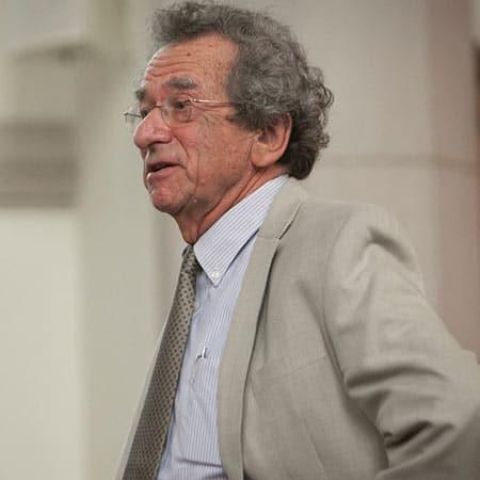N. David Mermin
Horace White Professor of Physics Emeritus
Quantum mechanics forbids statements about the object. It deals only with the object-subject relation. Schroedinger to Sommerfeld, 1931. A very early statement of QBism.
I retired in 2006, am no longer supervising Ph.D. students, and have no postdoctoral positions to offer.
1. From 1988 to 2009 I wrote thirty "Reference Frame" columns on a variety of topics for Physics Today. In 2016 they were all published by Cambridge University Press in Why Quark Rhymes with Pork, and Other Scientific Diversions. The columns are accompanied with brief remarks setting the historical context, reviewing later developments, and describing some of the reactions they elicited. Quark also contains thirteen longer essays. Versions of a few of these are available here: an expanded essay on Questions for the 22nd Century, a more detailed Diary of a Nobel Guest , some thoughts about Writing Physics, and twelve Onegin stanzas in praise of the Standard Model. Here is the table of contents.
2. I have tried to put the subject of quantum computation together in a way that makes sense to computer scientists unfamiliar with quantum mechanics, physicists unfamiliar with computational complexity theory, and philosophers of science. A book, Quantum Computer Science , incorporating my lecture notes was published by Cambridge University Press in August 2007. (Here are some errata.) It has been translated into Japanese (2009) and French (2010). And here are the slides from two lectures on the Shor algorithm , based on the book. My interest in quantum computation has grown out of a longstanding interest in foundations of quantum mechanics. My recent writings on quantum information and related foundational issues can be found at arxiv.org, and many of my most recent views are in Why Quark Rhymes with Pork . Several older essays on quantum mysteries for a more general audience (and much else) can be found in my earlier collection Boojums All the Way Through, Cambridge University Press, 1990. (Japanese translation (1994).) Here are the slides from a lecture on Spooky Actions at a Distance. And here is a lecture on QBism that I gave in Vienna in June, 2014.
3. I have a longstanding interest in the pedagogy and conceptual foundations of special relativity, having taught it on and off to Cornell students not majoring in science or mathematics for the past fifty years. For examples see the American Journal of Physics 65, 476-486 (1997) and 66, 1077-1080 (1998), and the relativity section of Boojums. My newer book on special relativity for the general reader, It's About Time: Understanding Einstein's Relativity was published (errata here) by Princeton University Press in September, 2005. It has been translated into Polish (2008), Romanian (2009), German (2016), and Greek (2017). (In 1968 I published Space and Time in Special Relativity. Since then I have learned much about teaching the subject.) Here are the slides from a physics colloquium on a purely geometric way to extract Minkowski's space-time diagrams straight from Einstein's postulates.
4. I participated in the old controversy between scientists and sociologists who study the growth of scientific knowledge, trying, with limited success, to explain to each side why the other thinks they are idiots. See, for example, my "Reference Frame" columns in the March 1996, April, 1996, and October 1997 issues of Physics Today (reprinted in Why Quark Rhymes with Pork). My critical review of the major introductory text in the field appeared in Social Studies of Science 28, 603-647 (1998), together with a response from the authors. I have given an assessment of these exchanges in my contribution to The One Culture, J. A. Labinger and H. Collins eds., University of Chicago Press, 2001.
5. I continue to work hard at the piano, particularly Beethoven and Mozart. And Mozart and Beethoven.
6. Some people wonder if I am the same N. David Mermin as the coauthor, with Neil Ashcroft, of Solid State Physics. I am. Although the book is still in its 1976 first edition, two thirds of it consists of eternal verities, and there is no time, even in a full-year course, to get to the remaining third. Our book has been translated into Russian (1979), Japanese (1981-2), Polish (1986), German (2001), French (2002), and Portuguese (2011). You can buy a new copy of the English edition at a reasonable price in England or order one from amazon.co.uk.
**Ashcroft and Mermin had nothing whatever to do with "Ashcroft, Mermin, and Wei", a "revised edition" which appeared in 2016. We learned about it by accident in August 2017. In answer to our subsequent inquiry, Professor Wei, whom we did not know and had not before corresponded with, said that she had not been told by her publisher, Cengage Asia, that nobody had asked for or received our approval or permission. Nor had our own publisher, Cengage Learning, said anything at all to us about a possible revision. We warn prospective readers of this "revised edition" that the unorthodox order of chapters in the first half of our original book, one of the strengths of our development of the subject, has been turned into the more conventional sequence. Our original edition remains in print and continues to be widely used.
7. Earlier in my career (1961-1995) I contributed to statistical physics (e.g. Mermin-Wagner theorem), low temperature physics (e.g. Mermin-Ho rel ation), solid state physics (e.g. Mermin-Lindhard dielectric constant), quantum chemistry (finite temperature density functional theory), the topological theory of defects, and the crystallographic classification of aperiodic crystals.
8. Here are my CV and publications as of September 10, 2018.
Research
Theoretical condensed-matter; foundations of quantum mechanics.
Educational Background
- Ph.D., Physics, Harvard University, 1961
- A.B., Mathematics, Harvard University, 1956

